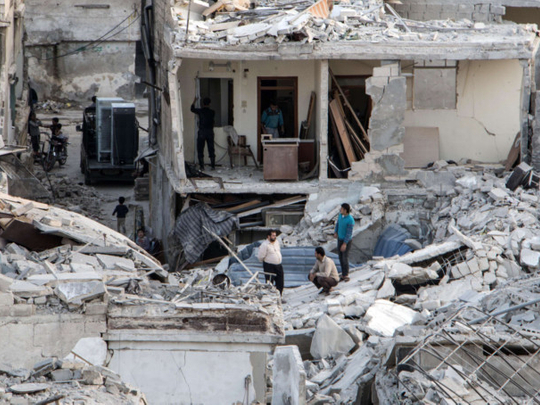
Stopped at the last minute in Kobani, the terrorist group known in the Arab world as Daesh — we do not use Islamic State, because the group is neither truly Islamic nor a state — is dispatching its murderers to other points along the Syrian-Turkish border. And at the end of the road lies Aleppo, the bastion of the moderate opposition.
Syria’s second-largest city and part of humanity’s ancient heritage, Aleppo is the martyred centre of the resistance to Syrian dictator Bashar Al Assad, having been under constant bombardment by his forces since 2012. Now Aleppo is caught between the regime’s “barrel bombs” and Daesh’s cutthroats.
The city is almost entirely encircled, connected to the outside world by a single road to Turkey. The regime is seeking to destroy the resistance through cold and hunger. While 1 million people have left to join the flood of Syrian refugees, some 300,000 Aleppans are holding on, threatened with the same death and destruction that the regime has inflicted on Homs and the suburbs of Damascus.
The dictator prefers to deliver Aleppo to terrorist atrocities, even if that means allowing Daesh to flourish on Aleppo’s eastern edge. Aleppo’s residents will then pay for Daesh’s setback in Kobani.
In fact, Al Assad and Daesh are two sides of the same barbaric coin. Al Assad largely created this monster by deliberately setting free the jihadists who fuelled this terrorist movement. This was part of his underhanded effort to appear, in the eyes of the world, as the sole bulwark against terrorism in Syria. But the facts contradict this charade. How many times has the regime — so ready to attack its own people — bombed Daesh? Did it ever try and save Kobani from disaster, even while the People’s Democratic Party, or PYD, fought at its side elsewhere? No, it chose to do nothing.
Political alternative
For these two faces of barbarism share a common aim: To destroy the moderate opposition. Thus, their choice to target its bastion, Aleppo, which represents the only political alternative capable of preserving the prospect of an open, pluralistic, democratic Syria — the Syria that both the regime and Daesh reject.
Abandoning Aleppo would mean condemning Syria to years of violence. It would mean the death of any political future. It would mean exporting Syria’s chaos to its already vulnerable Iraqi, Lebanese and Jordanian neighbours. It would mean the breakup of the country to be delivered up to increasingly radicalised warlords. And make no mistake — Al Assad, one “warlord” among others — will not defeat these rivals, just as he is incapable of defeating Daesh today.
Abandoning Aleppo would mean condemning 300,000 men, women and children to a terrible fate: Either a murderous siege under the regime’s bombs or the terrorist barbarity of Daesh.
France cannot resign itself to the breakup of Syria or to the abandonment of the Aleppans to this fate. That is why — together with our coalition partners — we must focus our efforts on Aleppo, with two clear objectives: Strengthening our support for the moderate Syrian opposition, and protecting the civilian population from the twin crimes of the regime and Daesh. After Kobani, we must save Aleppo.
— Washington Post








